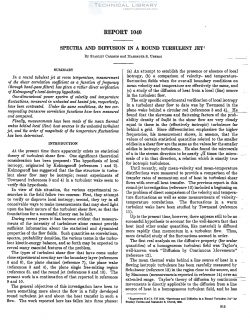naca-report-1040

- Version
- 95 Downloads
- 2.15 MB File Size
- 1 File Count
- September 1, 2016 Create Date
- September 1, 2016 Last Updated
National Advisory Committee for Aeronautics, Report - Spectra and Diffusion in a Round Turbulent Jet

In a round tubule-nt jet at room temperature, measurement
of the shear correlation coeficient as a function of frequency
(through band-passfitters) has giren a rather direct rem‘fication
of Kolmogorofi's local-isotropy hypothesis.
One-dimensional power spectra of velocity and temperature
fluctuations, measured in unheated and heated jets, respectively,
hare been contrasted. Under the same CO'Hd’lf‘hth, the two cor-
responding transverse correlation functions hare been measured
and compared.
Finally, measurements have been made of the mean thermal
u‘alces behind local (line) heat sources in the unheated turbulent
jet, and the order of magnitude of the temperature fluctuations
has been deter-mined.
At the present time there apparently exists no statistical
theory of turbulent. shear flow. One significant theoretical
consideration has been proposed: The hypothesis of local
isotropy, originated by Kolmogoroff (references 1 and 2).
Kolmogorofi‘ has suggested that the fine structure in turbu-
lent shear flow may be isotropic; recent- experiments of
Townsend (references 3 and 4) in a turbulent wake seem to
verify this hypothesis.
In view of this situation, the various experimental re-
searches in the field follow two courses: First, they attempt
to verify or disprove local isotropy; second, they try in all
conceivable ways to make measurements that may shed light
upon the basic nature of the turbulent shear flow, so that the
foundations for a successful theory can be laid.
During recent years it has become evident that measure-
ments of the intensity of turbulence alone cannot provide
sufficient information about the statistical and dynamical
properties of the flow fields. Such quantities as correlations,
spectra, probability densities, the various terms in the turbu-
lent kinetic—energy balance, and so forth may be expected to
reveal many essential features of the problem.
The types of turbulent shear flow that have come under
close experimental scrutiny are the boundary layer (references
5 and 6), the plane channel (reference 7), the plane wake
(references 3 and 4), the plane single free-mixing region
(reference 8). and the round jet (references 9 and 10). The
present work
| File | Action |
|---|---|
| naca-report-1040 Spectra and Diffusion in a Round Turbulent Jet.pdf | Download |

Comment On This Post